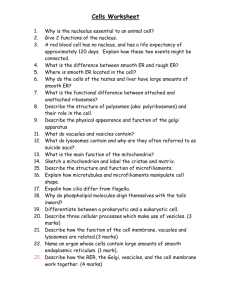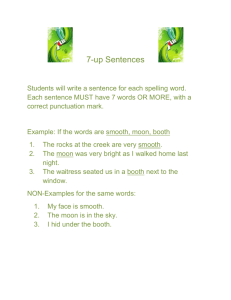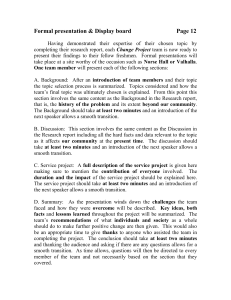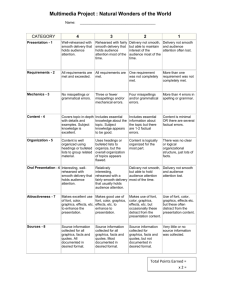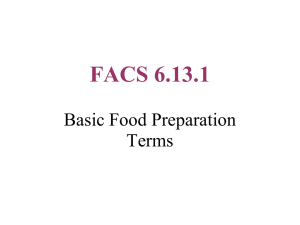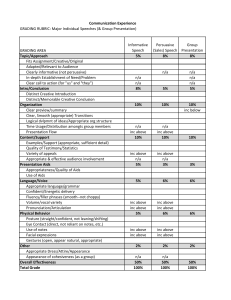Slides
advertisement
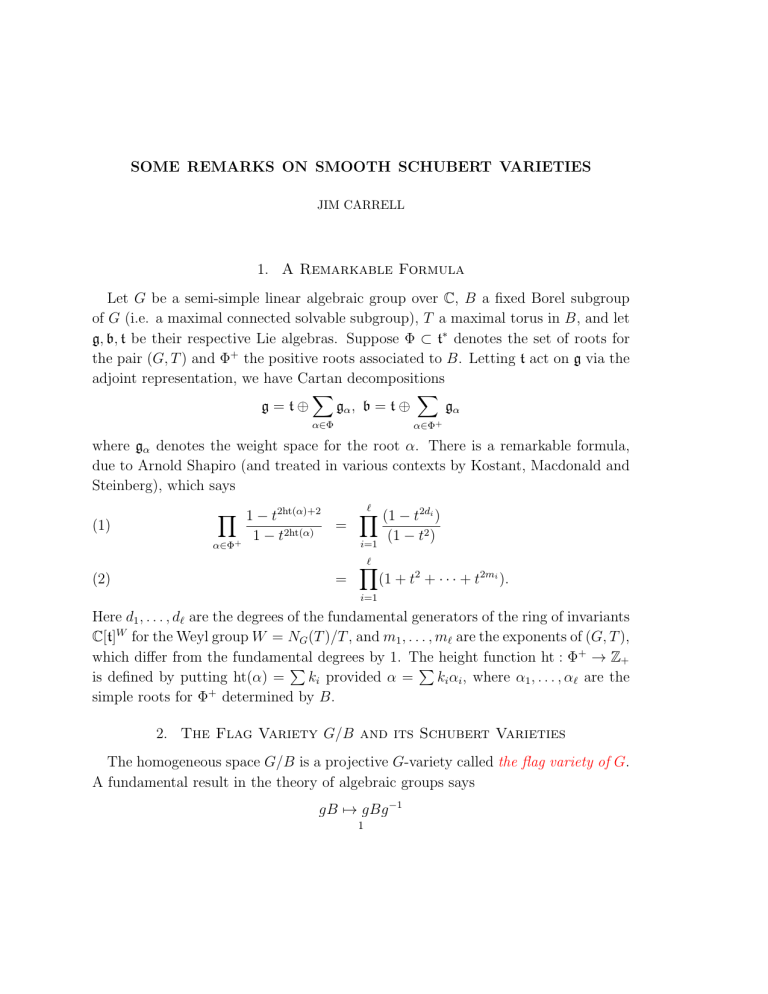
SOME REMARKS ON SMOOTH SCHUBERT VARIETIES
JIM CARRELL
1. A Remarkable Formula
Let G be a semi-simple linear algebraic group over C, B a fixed Borel subgroup
of G (i.e. a maximal connected solvable subgroup), T a maximal torus in B, and let
g, b, t be their respective Lie algebras. Suppose ⇢ t⇤ denotes the set of roots for
the pair (G, T ) and + the positive roots associated to B. Letting t act on g via the
adjoint representation, we have Cartan decompositions
X
X
g=t
g↵ , b = t
g↵
↵2
↵2
+
where g↵ denotes the weight space for the root ↵. There is a remarkable formula,
due to Arnold Shapiro (and treated in various contexts by Kostant, Macdonald and
Steinberg), which says
(1)
Y 1 t2ht(↵)+2
Ỳ (1 t2di )
=
1 t2ht(↵)
(1 t2 )
+
i=1
↵2
(2)
=
Ỳ
i=1
(1 + t2 + · · · + t2mi ).
Here d1 , . . . , d` are the degrees of the fundamental generators of the ring of invariants
C[t]W for the Weyl group W = NG (T )/T , and m1 , . . . , m` are the exponents of (G, T ),
which di↵er from the fundamental degrees by 1. The height function ht : + ! Z+
P
P
is defined by putting ht(↵) =
ki provided ↵ =
ki ↵i , where ↵1 , . . . , ↵` are the
+
simple roots for
determined by B.
2. The Flag Variety G/B and its Schubert Varieties
The homogeneous space G/B is a projective G-variety called the flag variety of G.
A fundamental result in the theory of algebraic groups says
gB 7! gBg
1
1
2
JIM CARRELL
is a bijection between G/B and the set of all Borel subgroups of G. By the Bruhat
decomposition G = BW B, B acts on G/B with only finitely many orbits BwB/B.
The Zariski closure Xw = BwB/B is called the Schubert variety associated to w.
Example. If G = GL(n, C), then we may take B to be the upper triangular matrices
and T the diagonal matrices in B. A nonsingular matrix defines a complete flag via
the spans of its columns, and the isotropy group of the identity is B. Thus G/B
parameterizes the set of complete flags in Cn .
Let h ⇢ t⇤ denote the real span of . If ↵ 2 , let r↵ denote the reflection of
h through the hyperplane ↵ = 0 (with respect to a W -invariant inner product).
Then r↵ 2 W , and the set S of simple reflections (associated to the simple roots)
. (W, S) defines a Coxeter system, so W has a length function ` : W ! Z+ and a
partial order known as the Bruhat order. The following fundamental properties
of Schubert varieties are due to Chevalley.
• For any w 2 W , the B orbit BwB/B is an affine space of (complex) dimension
`(w). Consequently, the decomposition
[
G/B =
BwB/B
w2W
is an affine paving of G/B.
• For all x, w 2 W , BxB/B ⇢ BwB/B i↵ x w. Thus,
[
Xw =
BxB/B.
xw
P
i
• Let Pw (t) denote the Poincaré polynomial 2`(w)
i=0 bi (Xw )t . Then
X
Pw (t) =
t2`(x) .
xw
Consequently, the odd Betti numbers of a Schubert variety vanish.
3. The tangent space TeB (Xw ) of a smooth Schubert variety
A Schubert variety which is nonsingular as an algebraic variety is said to be smooth.
Suppose w 2 W , ↵ > 0 and r↵ w. Then it follows that g ↵ ⇢ TeB (Xw ). In general,
let
(w) = {↵ > 0 | r↵ w}.
SOME REMARKS ON SMOOTH SCHUBERT VARIETIES
By Deodhar’s Inequality [PSPM1994], | (w)|
Xw is smooth.
• If Xw is smooth, then
TeB (Xw ) =
X
3
`(w) for all w 2 W with equality if
g
↵,
↵2 (w)
but not conversely.
The relevance of the above identity is this: Since the connected solvable group B
acts on (any) Xw with the unique fixed point eB = B/B, it follows from the Borel
Fixed Point Theorem that Xw is smooth i↵ the Zariski tangent space TeB (Xw ) has
dimension `(w). Note that TeB (Xw ) is always B-module, hence also a b-module.
This greatly restricts what form (w) can take and suggests the following question.
P
Question: Suppose is a set of positive roots and f = ↵2 g ↵ is a B-submodule
of g/b. That is, for any ↵ 2 , if , ↵
> 0, then ↵
2 . Does this imply
f = TeB (Xw ) for a smooth Schubert variety Xw with | | = `(w)?
4. The Poincaré Polynomial of a smooth Schubert variety
One can (sort of) generalize the remarkable formula (1) and (2) for a smooth
Schubert variety as follows. Put hi = |{↵ 2 (w) | ht(↵) = i}|. Clearly, h1 > 0.
• If Xw is smooth, then hi
hi+1 for all i > 0.
The above inequality fails in the singular case, as the following example shows.
Example Suppose ↵ and denote respectively the short and long simple roots of
type B2 , and let w = r↵ r r↵ . Then (w) = {↵, , 2↵ + }. Thus, h1 = 2, h2 = 0,
and h3 = 1.
Suppose Xw is smooth and hk > 0 but hk+1 = 0. Let di = hi
Then,
Y 1 t2ht(↵)+2
(3)
Pw (t) =
1 t2ht(↵)
↵2 (w)
Y
(4)
=
(1 + t2 + · · · + t2i )di .
hi+1 and dk = hk .
1ik
Note that in the case Xw = G/B, (4) explicitly gives the exponents of (G, T ) along
with their multiplicities. It also suggests possible exponents for smooth Schubert
varieties, but doesn’t give any geometric interpretation of these exponents.
4
JIM CARRELL
Let us briefly (and somewhat vaguely) explain how this formula comes about.
More details can be found in [MMJ2012]. Suppose X is a smooth projective variety
of dimension n over C which admits an action of the upper triangular subgroup B
of SL2 (C) such that the unipotent radical Bu has unique fixed point, say o. The
maximal torus T ⇢ B on the diagonal defines a Gm -action on X whose big open cell
U is an affine cell about o which is T-isomorphic with To (X), o going to the origin.
This induces natural T-homogeneous coordinates u1 , . . . , un on U . If V denotes the
algebraic vector field on X induced by Bu , then the functions ai = V (ui ) define a
regular homogeneous sequence (supported at o). Thus the ideal (a1 , . . . , an ) defines
a punctual scheme Z supported at o. The key fact is that there exists a graded
C-algebra isomorphism
C[Z] = C[u1 , . . . , un ]/(a1 , . . . , an ) ⇠
= H ⇤ (X, C).
By elementary commutative algebra, the Poincaré polynomial of X satisfies
PX (t) =
n
Y
1
i=1
1
tdeg(ai )
.
tdeg(ui )
Using the fact that an arbitrary Xw admits such an action, the formula (3) for
Pw (t) in the smooth case follows from an elementary calculation. The reason that
any Xw admits an action of B as above is more interesting. It involves a choice of
principal nilpotent e in b. Let e↵ 2 g↵ be nonzero, and put
e=
X̀
e ↵i .
i=1
(Recall, the ↵i are the simple roots.) Thus we obtain a Ga -action on Xw from the
one parameter group s ! exp(se), which induces an action of B by standard results.
The reason Bu has eB as its unique fixed point is that the unique Borel subalgebra
containing e is b.
Formula (3) suggests the following
Question: Suppose (3) holds for Xw . Does this imply Xw is smooth?
Unfortunately, there is a counter example in type G2 . However, this is the only
counter example the author knows of.
SOME REMARKS ON SMOOTH SCHUBERT VARIETIES
5
5. The Poincaré Polynomial and Rational Smoothness
There is a well known weakening of the notion of smoothness, called rational
smoothness, which was studied in depth by Kazhdan and Lusztig in the context of
representation theory. The definition is too technical to give here, but we can state
a list of conditions (some elementary) equivalent to rational smoothness.
Theorem (see [PSPM1994]) The following are equivalent:
(a) Xw is rationally smooth;
(b) if x w, then the Kazhdan-Lusztig polynomial Px,w (q) = 1;
(c) Pw (t) is palindromic; and
(d) every vertex of the Bruhat graph of Xw is on exactly `(w) edges.
The equivalence of (a) and (b) is a deep result due to Kazhdan and Lusztig. The
equivalence of (b), (c) and (d) is due to the speaker and Dale Peterson. The Bruhat
graph of Xw is the graph whose vertices are the xB, where x w. Two vertices
xB, yB are joined by an edge i↵ they lie on a T -stable curve in Xw . Since the fixed
point set (Xw )T coincides with {xB | x w}, the Bruhat graph coincides with what
is often called the momentum graph of the pair (Xw , T ). Every T -stable curve C
in G/B contains exactly two fixed points, which have the form xB and r↵ xB for a
unique ↵ > 0. If x 1 (↵) < 0, then C is the closure of x↵ (C)xB, where x↵ : C ! B
is the root subgroup associated to ↵. If x, r↵ x w, then C ⇢ Xw .
Since smooth Schubert varieties are obviously rationally smooth, one can ask which
rationally smooth Schubert varieties are smooth. This is partially answered by a
beautiful result of Peterson
Theorem If G is of type ADE, then every rationally smooth Schubert variety in
G/B is in fact smooth.
The proof uses a notion we will briefly explain below, namely Peterson translates.
More generally, we have the following recent result which brings into context the
question of when (w) defines a b-module.
• If G doesn’t contain any G2 -factors and Xw is rationally smooth, then Xw is smooth
P
i↵ ↵2 (w) g ↵ is a b-submodule of TeB (Xw ).
We refer to [TG2011] for the proof. The following amusing corollary is a simple
consequence.
6
JIM CARRELL
• For any w, Xw is smooth i↵ Xw
1
is smooth.
6. The Inversion Arrangement and a result of Oh, Postnikov and
Yoo
Recall that the inversion set of w 2 W is by definition
I(w) = {↵ > 0 | w(↵) < 0}.
Note that this means I(w 1 ) is precisely the set of T -weights for TwB (Xw ). Note also
that wB is always a smooth point of Xw . Recently, Oh, Postnikov and Yoo [JCT2010]
proved the following surprising result for rationally smooth (hence smooth) Schubert
varieties in type A. This was later extended by Oh and Yoo to rationally smooth
Schubert varieties in classical types.
Theorem Assume G = SL(n, C), and consider the hyperplane arrangement A in h
(see Section 1) defined by the hyperplanes ↵ = 0 for all ↵ 2 I(w). Let Rw (t) denote
the wall crossing polynomial for this arrangement. Then a Schubert variety Xw is
(rationally) smooth i↵ Rw (t) = Pw (t).
The wall crossing polynomial is defined as follows. Fix a connected component C0
of the complement h\A, and for any other component C, let n(C, C0 ) denote the
number of walls one needs to cross to pass from C0 to C. Then
X
Rw (t) =
t2n(C,C0 ) .
C
Although this result is useless in practice, it establishes a beautiful link between
global smoothness (or rational smoothness) and the inversion arrangement.
Question: Since I(w 1 ) consists of all T -weights of TwB (Xw ) and Rw (t) = Rw 1 (t),
is there a criterion to determine when Xw is smooth just from I(w)?
7. Peterson translates and the inversion set
In this section, we will describe an explicit map from I(w) to (w) in the smooth
setting. This map is defined for all I(w) but it turns out in general to be multi-valued
in the singular case. Fix Xw and assume x, r↵ x w. When ↵ > 0 and x 1 (↵) < 0,
then r↵ x < x. Recall that the one parameter group x↵ : C ! B gives the T -stable
curve C(x, ↵) = x↵ (C)xB in Xw whose fixed point set is {xB, r↵ xB}. The limit
lim dx↵ (s)TxB (Xw )
s!1
SOME REMARKS ON SMOOTH SCHUBERT VARIETIES
7
exists as a T -stable subspace of Tr↵ xB (Xw ) called the Peterson translate of TxB (Xw )
along C(x, ↵). If Xw is smooth at xB and r↵ xB, then we can view this map as
being a bijection of the set of T -weights for TxB (Xw ) to those of Tr↵ xB (Xw ). We
note that although the above definition works in the complex case, a more subtle
approach works for any algebraically closed field, independent of the characteristic.
See [INVENT2003] for more details.
Irregardless of whether or not Xw is smooth, one can use Peterson translation
along any path in the Bruhat graph of Xw from wB to eB by applying Peterson
translation to the successive translates. This gives a map depending on the path P
from wB to eB taking the T -weights at wB to those at eB, but in general, this map
fails to be onto the weights of TeB (Xw ), and in general it depends on the path. The
following result seems to be of some importance.
• Xw is smooth i↵ Peterson translation from wB to eB is independent of path in the
Bruhat graph of Xw .
The main question is thus how to determine when Peterson translation is independent of path. A secondary question is how to use Peterson translation to determine
when Xw is rationally smooth. Unfortunately, the natural approach doesn’t seem to
work: Peterson translation doesn’t leave the wall crossing polynomial invariant. But
how it changes isn’t clear yet. Some conjectures have been made by Ed Richmond
and William Slofstra, and it is hoped that there will be further developments.
8. References
[MMJ2012] E. Akyildiz and J.B. Carrell: Betti numbers of smooth Schubert varieties
and the remarkable formula of Kostant, Macdonald Shapiro and Steinberg. To appear
in Michigan Math. Journal (2012).
[PSPM1994] J. B. Carrell: The Bruhat Graph of a Coxeter Group, a Conjecture of
Deodhar, and Rational Smoothness of Schubert Varieties, Proc. Symp. in Pure Math.
56, No. 2, (1994), Part 1, 53–61.
[TG2011] J. B. Carrell: Smooth Schubert varieties in G/B and B-submodules of g/b,
Transf. Groups 16 (2011), 673-680.
[INVENT2003] J. B. Carrell and J. Kuttler: Singular points of T -varieties in G/P
and the Peterson map, Invent. Math. 151 (2003), 353–379.
8
JIM CARRELL
[JCT2008] S. Oh, A. Postnikov and H. Yoo: Bruhat order, smooth Schubert varieties,
and hyperplane arrangements, J. Combin. Theory Ser. A 115 (2008), no. 7, 1156–
1166.
Jim Carrell
Department of Mathematics
University of British Columbia
Vancouver, Canada V6T 1Z2
carrell@math.ubc.ca
